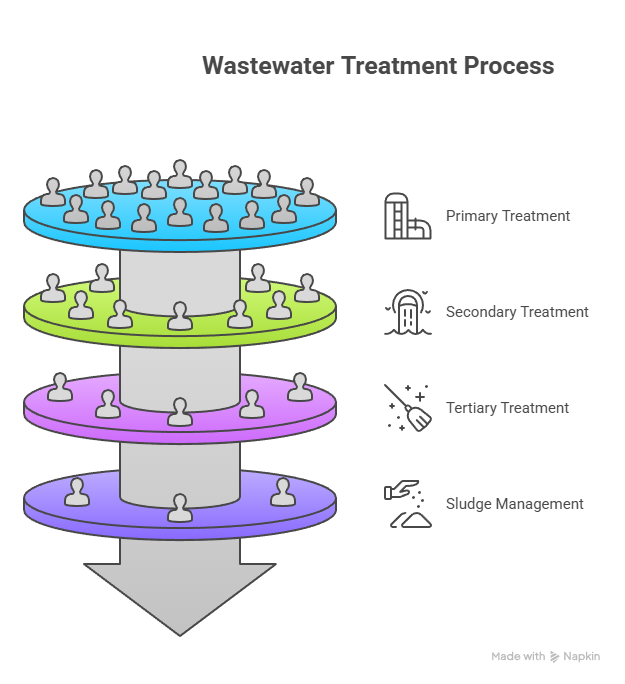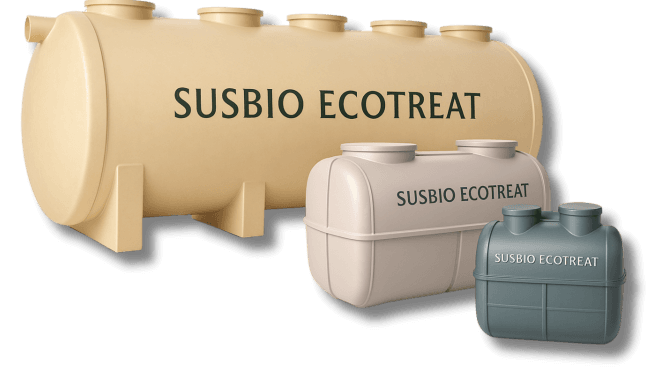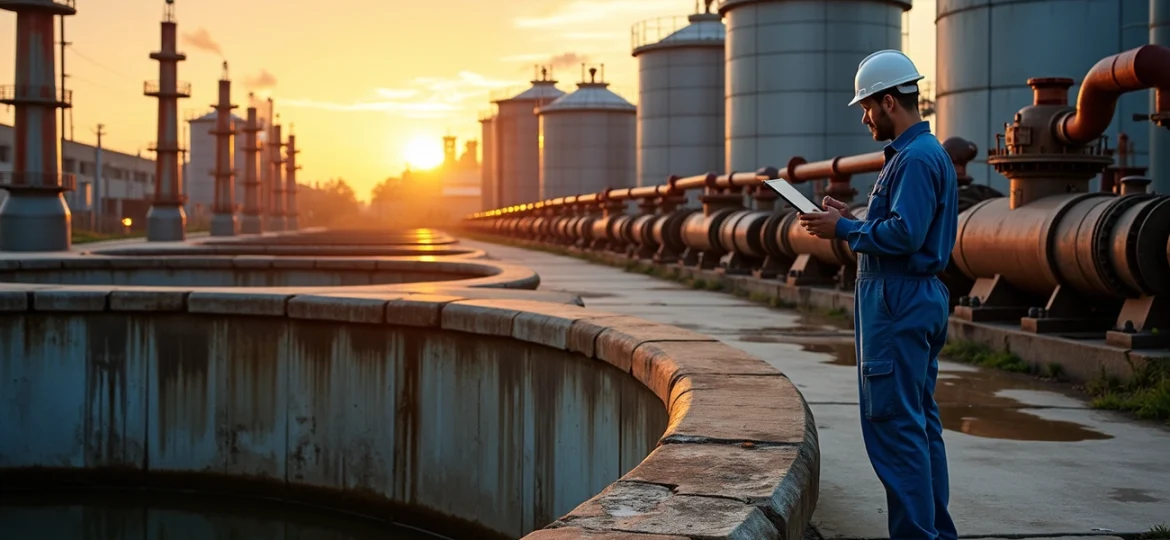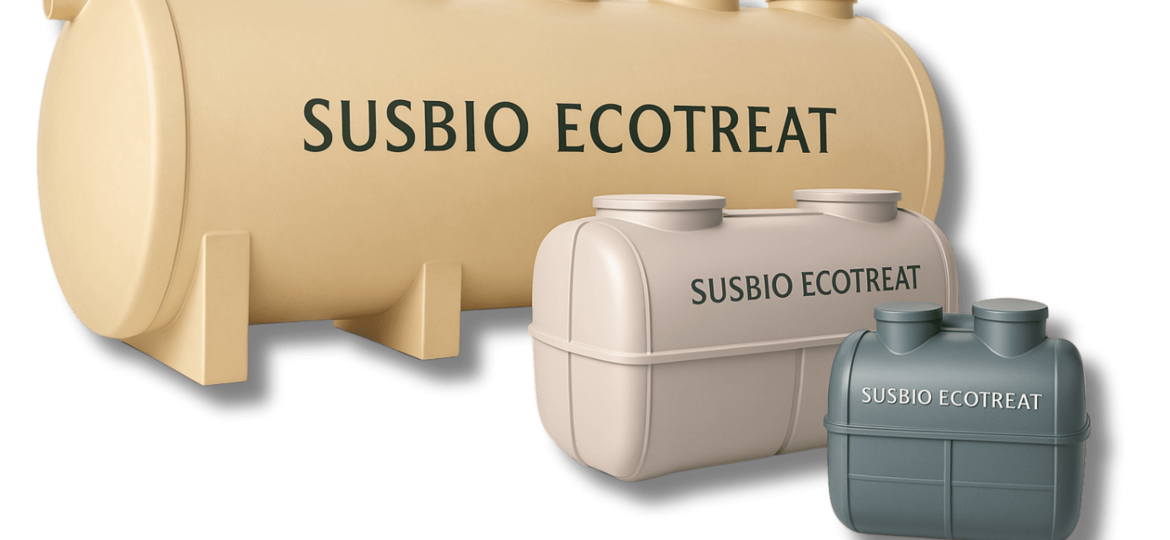India generates over 72,000 million liters of sewage daily, yet only a small portion receives proper wastewater treatment. The country’s groundwater levels have dropped by more than 60% in just two decades in some regions. This alarming situation calls for green water management solutions.
The Jal Jeevan Mission (JJM) was launched by the Indian government to tackle this crisis. Their goal is to provide safe and adequate drinking water to all rural households by 2024. Millions of liters of untreated sewage flow directly into natural water bodies each day and contaminate valuable water resources. Sewage Treatment Plants (STPs) serve as a vital component in preventing this contamination. These plants treat wastewater through physical, biological, and chemical processes to ensure only safe water returns to the environment. The reuse of treated wastewater for irrigation and industrial processes has led to a notable drop in freshwater demand throughout India.
This piece explores how STPs are changing India’s water landscape through multi-stage treatment processes. We’ll get into their effect on rural communities and showcase advanced technologies like SUSBIO ECOTREAT—the most advanced packaged STP in India that provides a future-ready solution for our growing water challenges. Cities will house more than 40% of our population by 2030. This makes effective wastewater management both an environmental and economic necessity.
Why STPs Are Central to Jal Jeevan Mission’s 2025 Vision

The Jal Jeevan Mission’s 2025 vision depends on Sewage Treatment Plants (STPs) as key infrastructure elements. These facilities are the foundations of green water management in rural India. They tackle several challenges at once through systematic wastewater treatment.
Preventing groundwater and river pollution from untreated sewage
Raw sewage poses one of the biggest threats to India’s water bodies. It introduces harmful pathogens, excess nutrients, and toxic chemicals that destroy aquatic ecosystems when it enters rivers and seeps into groundwater. STPs break this cycle by capturing and processing wastewater before it reaches natural water systems.
Modern STPs like SUSBIO ECOTREAT use multi-stage wastewater treatment to remove contaminants. Physical screening removes large debris while sedimentation settles out suspended solids during primary treatment. The secondary treatment breaks down organic matter through biological methods. Final purification happens through advanced filtration and disinfection in tertiary treatment.
Reducing waterborne diseases in rural communities
Rural populations face higher health risks from contaminated water sources. Communities see more cases of cholera, typhoid, dysentery, and other waterborne illnesses without proper sewage management. Villages can significantly lower disease risks in their water supplies by installing STPs.
Biological wastewater treatment plays a crucial role in reducing pathogens. Activated sludge systems and advanced oxidation processes eliminate harmful microorganisms before water returns to the environment. This creates a safety barrier between human waste and community water sources.
Enabling water reuse for agriculture and non-potable use
The most innovative aspect of adding STPs to the Jal Jeevan Mission is water reclamation. Treated water becomes a valuable resource for farming, landscape maintenance, and industrial use—which reduces strain on freshwater supplies.
The complete domestic wastewater treatment turns waste into a sustainable water source. STPs produce safe water for non-potable reuse through carefully designed treatment processes. This circular approach to water management makes solutions like SUSBIO ECOTREAT—India’s most advanced packaged STP—essential for water security in rural communities.
Stages of Wastewater Treatment Process in STPs

Sewage treatment plants clean wastewater through a series of steps. Each step removes specific pollutants and purifies water to meet environmental standards for safe disposal or reuse.
Primary Treatment: Screening and sedimentation
The first step starts with preliminary screening that captures large debris like plastic, paper, and food scraps through screens with spacing between 15-25mm. Water moves slowly through grit chambers where heavier particles like sand and gravel settle down. Large tanks then allow primary sedimentation where gravity separates suspended solids. Heavy solids sink to create sludge while oils and grease float to the surface for removal. This process removes 50-60% of suspended solids and cuts biological oxygen demand (BOD) by 30-40%.
Secondary Treatment: Biological degradation using activated sludge
The next phase targets dissolved organic matter through biological processes. The activated sludge process is accessible to more people and uses microorganisms to consume organic pollutants. Bacteria and other microbes digest organic waste under varying oxygen conditions in aeration tanks. This biological action removes over 90% of remaining suspended solids and reduces BOD substantially. The mixture then flows into a secondary clarifier where activated sludge settles at the bottom while clean water flows out.
Tertiary Treatment: Disinfection using UV or chlorination
The final stage focuses on eliminating pathogens through advanced purification techniques. Chlorination, UV radiation, and ozonation are common disinfection methods. UV treatment achieves 3.4-4.2 log reduction of antibiotic-resistant bacteria at a fluence of 220 mJ/cm². SUSBIO ECOTREAT, India’s most advanced packaged STP, uses advanced tertiary treatment technologies that exceed standard requirements. This makes it a future-ready solution for rural communities.
Sludge Management: Biogas and compost generation
The process thickens residual sludge to increase solids concentration. Dewatering techniques then achieve up to 35% dry matter content. Anaerobic digestion turns organic matter in sludge into biogas with 50-75% methane. This biogas powers electricity generation. The process reduces sludge volume by up to 85% and creates valuable renewable energy.
Reuse and Safe Disposal: Irrigation and landscaping applications
Tertiary-treated effluent helps reclaim water for irrigation and landscaping. STPs across India reuse about 50 MLD of treated wastewater for these purposes. The European Union applies about 50% of its total sludge production to agricultural soils. This provides essential nutrients like phosphorus and nitrogen, reduces synthetic fertilizer needs, and completes the circular approach to wastewater management.
STP Technologies Supporting Jal Jeevan Mission
The Jal Jeevan Mission uses several innovative STP technologies to meet India’s geographical and demographic challenges. These solutions are customized to specific regional needs.
Moving Bed Biofilm Reactor (MBBR) for decentralized systems
MBBR technology offers an ideal solution for small decentralized wastewater treatment because of its compact design and simple operation. The system uses specially designed plastic biocarriers that create a large surface area where microbes can grow. This enables quick organic matter removal without needing extensive infrastructure. MBBR systems can upgrade existing conventional activated sludge performance with minimal changes to host configurations. Delhi Development Authority has successfully used MBBR-based decentralized STPs to treat wastewater from nearby sewers, which helps meet irrigation needs in parks.
Sequencing Batch Reactor (SBR) for variable load handling
SBR technology stands out in managing fluctuating wastewater flows in rural communities. This modified activated sludge process works in time-based sequences instead of separate spaces, making it highly adaptable. SBRs consistently keep BOD levels under 5 mg/L and total nitrogen below 5 mg/L through aerobic, anaerobic, and anoxic treatment phases. These systems cut operating expenses by over 60% compared to conventional methods. The SBR process handles landfill leachate and other challenging wastewaters effectively through its flexible operational parameters.
Constructed Wetlands for low-energy rural setups
Constructed wetlands provide a green, economical alternative for wastewater treatment in rural areas. These systems combine septic tanks with wetland components and achieve impressive removal rates: 87% for TSS, 89% for COD, 93% for BOD, and pathogen removal up to 4.0 log10. Subsurface flow constructed wetlands prevent insect breeding while creating valuable wildlife habitats. Many rural communities now use these natural systems that need minimal maintenance yet produce high-quality effluent suitable for agricultural reuse.
Anaerobic Digesters for biogas generation
Anaerobic digesters turn sewage sludge into valuable biogas with 50-75% methane content, turning waste into renewable energy. Bacteria break down organic matter without oxygen in sealed reactors, producing both biogas and nutrient-rich digestate. You can separate the solid and liquid portions of digestate and use them as animal bedding, fertilizer, or soil amendments. This creates additional revenue streams or helps save costs. Anaerobic digestion helps rural communities handle both waste management and energy needs.
SUSBIO ECOTREAT: India's most advanced packaged STP
SUSBIO ECOTREAT stands as India’s innovative packaged STP solution that blends advanced technology with practical design. Its unique dual treatment process combines anaerobic and aerobic methods for superior purification. This prefabricated system uses 90% less electricity than traditional STPs and needs minimal human intervention. The fiber-reinforced plastic construction ensures durability and quick installation, making it perfect for residential projects across India. SUSBIO ECOTREAT’s modular design allows easy capacity adjustments, making it a future-ready solution for India’s evolving wastewater challenges.
Impact and Challenges of STP Implementation in Rural India
Sewage Treatment Plants are changing rural water ecosystems in India. These systems must balance environmental benefits with operational challenges that still exist today.
Improved water quality in rivers and lakes
STPs placed at strategic locations have substantially improved surface water quality. They prevent untreated sewage from flowing into natural water bodies. Better water quality helps restore biodiversity and supports aquatic ecosystems. Local communities that depend on these water resources can now sustain their livelihoods better. India’s rivers and lakes have served as the foundations of civilization. These water bodies now stand a better chance against pollution thanks to proper wastewater treatment.
Increased freshwater availability for drinking
Treated wastewater now flows to irrigation and industrial uses. This has reduced the pressure on freshwater resources. The change means more clean water stays available for drinking and household needs. This directly supports the Jal Jeevan Mission’s goals. A treated wastewater recycling project in Kolar, Karnataka showed impressive results. The area’s groundwater levels rose by 53-73% after implementation.
Barriers: High capital cost and land constraints
Building STPs comes with major financial hurdles:
- Traditional STPs cost about Rs 1 crore per million liters daily (MLD) capacity
- Medium-sized STPs (100 MLD) need Rs 70 lakh to Rs 2 crore yearly for maintenance
- Finding enough land in crowded areas remains a challenge
SUSBIO ECOTREAT stands as India’s most advanced packaged STP. It offers a future-ready solution that needs less space while delivering better treatment results.
Need for skilled manpower and community awareness
Rural areas often lack the specialized knowledge needed to run STPs effectively. Many communities don’t understand why wastewater treatment matters, which leads to underused infrastructure. People resist these projects because they worry about smell, pollution, and poor management. These issues need detailed community education programs to resolve them.

Conclusion
This piece explores how Sewage Treatment Plants play a crucial role to curb India’s water crisis under the Jal Jeevan Mission. STPs keep untreated sewage from polluting our water bodies. They also create new water resources through reuse applications.
The treatment happens in multiple stages – from primary screening to advanced disinfection. This process gives a detailed removal of contaminants and makes wastewater safe for environmental release or reuse. Rural communities see huge benefits from fewer waterborne diseases. They also get more water for agriculture through these systematic treatment methods.
Technology breakthroughs have adapted to India’s varied geographical challenges. Moving Bed Biofilm Reactors give compact solutions for decentralized systems. Sequencing Batch Reactors handle different loads quickly. On top of that, constructed wetlands serve as low-energy options that work perfectly in rural settings. These options show modern wastewater management’s versatility.
SUSBIO ECOTREAT, without doubt India’s most advanced packaged STP, shows the peak of these technological advances. This future-ready solution mixes both anaerobic and aerobic methods. It needs minimal electricity and human intervention. Its modular design lets users adjust capacity as needed, making it perfect to tackle India’s changing wastewater challenges.
Despite good progress, some problems are systemic. High capital costs, land constraints, and lack of skilled workers still limit rural India’s STP implementation. Strong community education and awareness programs must go hand in hand with infrastructure growth to last long.
India’s water map changes depend heavily on our steadfast dedication to proper wastewater management. STPs protect existing water resources and create new ones through reuse. This all-encompassing approach ended up supporting Jal Jeevan Mission’s goal – providing safe drinking water to every rural home while protecting water resources for future generations.
Key Takeaways
India’s water crisis demands immediate action through systematic wastewater treatment, and STPs are proving to be the cornerstone solution for sustainable water management in rural communities.
- STPs prevent 72,000 million liters of daily sewage from contaminating groundwater and rivers, protecting India’s precious water resources from further degradation.
- Multi-stage treatment processes remove 90% of suspended solids and enable water reuse for agriculture, reducing freshwater demand significantly.
- Advanced technologies like MBBR, SBR, and constructed wetlands offer flexible, energy-efficient solutions tailored to diverse rural community needs.
- SUSBIO ECOTREAT represents India’s most advanced packaged STP, using 90% less electricity while requiring minimal human intervention for operation.
- Despite high capital costs and skilled manpower challenges, STPs have increased groundwater levels by 53-73% in implemented areas like Kolar, Karnataka.
The success of the Jal Jeevan Mission’s 2025 vision hinges on widespread STP adoption, transforming wastewater from a pollution source into a valuable resource for irrigation and industrial use while safeguarding public health in rural India.
Frequently Asked Questions
Q1. What is the role of Sewage Treatment Plants (STPs) in the Jal Jeevan Mission?
STPs play a crucial role in preventing water pollution, reducing waterborne diseases, and enabling water reuse for agriculture and non-potable purposes. They are central to the mission’s goal of providing safe drinking water to rural households by 2024.
Q2. How do STPs improve water quality in India?
STPs use multi-stage treatment processes to remove contaminants from wastewater. This includes primary treatment for screening and sedimentation, secondary treatment for biological degradation, and tertiary treatment for disinfection. These processes significantly reduce pollutants before water is released back into the environment.
Q3. What are some innovative STP technologies being used in India?
Several innovative technologies are being implemented, including Moving Bed Biofilm Reactors (MBBR) for decentralized systems, Sequencing Batch Reactors (SBR) for variable load handling, and Constructed Wetlands for low-energy rural setups. SUSBIO ECOTREAT is considered India’s most advanced packaged STP solution.
Q4. What challenges does India face in implementing STPs in rural areas?
The main challenges include high capital costs, land constraints, lack of skilled manpower, and low community awareness. Conventional STPs can be expensive to set up and maintain, and acquiring sufficient land in densely populated areas can be problematic.
Q5. How do STPs contribute to water conservation in India?
STPs enable water reuse for irrigation and industrial processes, significantly reducing the demand for freshwater. This helps conserve water resources and increases the availability of clean water for drinking and household purposes, directly supporting the goals of the Jal Jeevan Mission.






